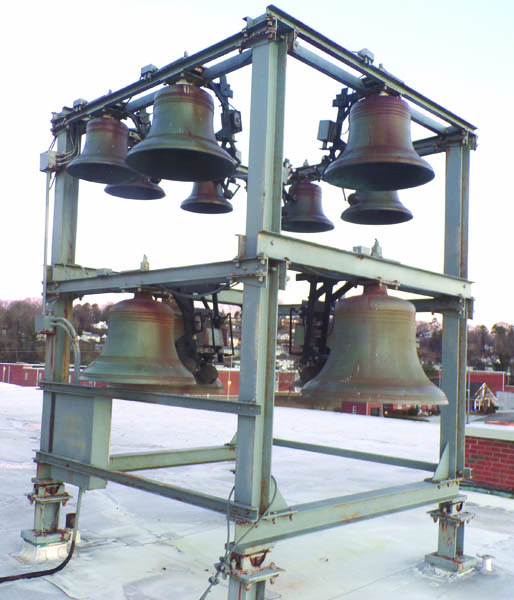Bells may be ringing
Request has been made for funds to update electronic ringer mechanism

These 11 bells mounted on the courthouse roof were a gift to the area citizens in 1937 from Samuel L. Slover in mem- ory of his father, Henry Clay Slover. They range in weight from 225 to 2,000 pounds each, totaling 8,375 pounds. (photo:Pete Gwada )
The bells were given to the county in 1937 in memory of a prominent citizen, Henry Clay Slover, by his son, Samuel L. Slover.
The 11 bronze bells, ranging in size from 225 to 2,000 pounds each, with a total weight of 8,375 pounds, were originally mounted in the clock tower of the previous courthouse.
The Clinton Courier on Thursday April 15, 1937, described the bells as “the highest possible grade, with clear, musical tones and will not only be heard throughout the town but, under favorable weather conditions, they should carry a long distance in the surrounding country.”
Originally, the clock struck four notes on the first quarter hour, eight at the second, 12 at the third and 16 at the hour.
Music could be played from a keyboard and also mechanically using rolls similar to player piano rolls.
Currently the bells are in good shape but the ringing mechanism is outdated, according to Roger Lloyd, who in his capacity as buildings director for Anderson County, is the official “keeper of the bells.”
An electronic console in a cabinet in the third floor courtroom controls the operation of the bells.
The bells are accessed by a spiral staircase winding from the third floor to the roof of the courthouse.
Lloyd said the bells have not worked in about 8 years. When they were working properly, they chimed on the quarter hours, and music could be played using special discs. However, they may soon be heard again. Lloyd has an estimate of about $25,000 for repair of the bells, which he will be presenting to the county commissioners for approval.
When Samuel Slover presented the bells to the county, it was under the condition that should the clock no longer be used, it would go to First Baptist Church. If First Baptist did not want it, it was to go to some other Clinton church.
Samuel Slover attended Clinton schools and the University of Tennessee before going into newspaper work. His father was born and raised in Anderson #County, served in the Union Army during the Civil War, was captured and spent time as prisoner of war at the infamous Andersonville prison. The elder Solver served as circuit clerk and as clerk and master for a number of years.
The chimes are associated with two famous foundries. The bells were cast by Meneely Bell Company of Troy, N.Y., in 1937.
Until it went out of business in 1951 Meneely Bell Company had existed in one form or another since 1826. More recent updating has been done by the Verdin Company known as, “The Bell Ringers of America.”
Meneely bells are found in churches, city halls, courthouses and universities all over the country. Perhaps the most famous bell cast by Meneely was the Centennial Bell. It was cast for the nation’s centennial in 1876 and is now heard tolling the hours from the clock tower on Independence Hall in Philadelphia.
More recent work on the bells has been done by the Verdin Company.
In 1967 the Verdin Company sandblasted and polished the bells, fitted them with custom solenoid striking units and mounted them atop the present courthouse for a total cost of $13,625. Through the years Verdin has replaced the solenoids from the time. The bells were overhauled in 1996 and rededicated May 24, 1997.
The Verdin Brothers foundry started its life by installing a church clock in 1842 in Cincinnati. In the late 1800s the company began manufacturing the hardware to hang bells. In 1926 I. T. Verdin invented electric ringing devices for clocks. The business expanded to include the manufacture, sales and installation of cast bronze bells. In the early 1950s Verdin entered the electronic carillon field. Among other sites all over the country Verdin bells are heard pealing from St. Louis Cathedral in New Orleans, Busch Gardens at Williamsburg, Va., and the Mayo Clinic in Rochester, N.Y.
